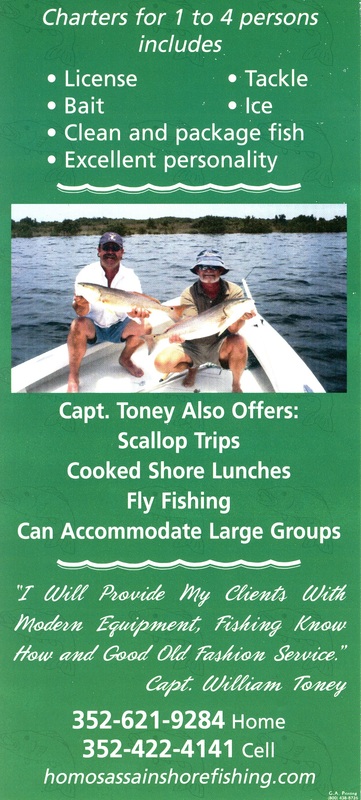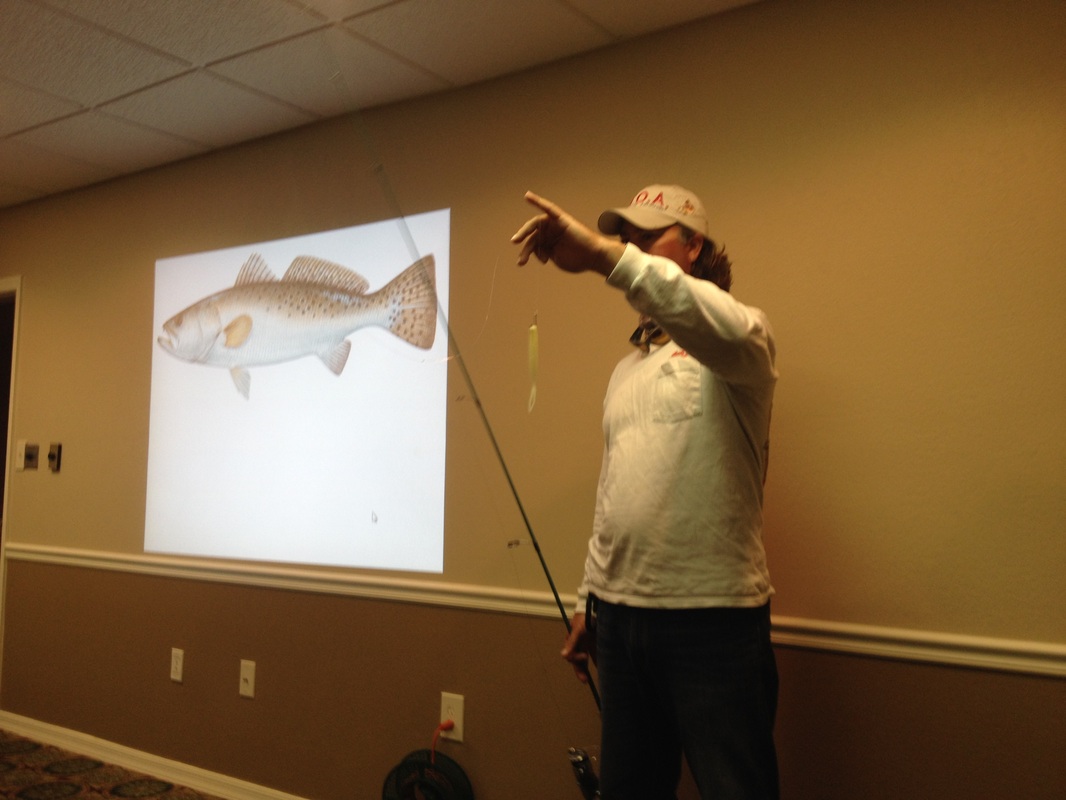Captain William Toney, President of the Homosassa Guides Association, operates his own charter boat fishing business called Homosassa Inshore Fishing. http://homosassainshorefishing.com/ He was one of our guest speakers last year (2014) introducing the Spotted Seatrout species to us and teaching us some of the best ways to target and catch them. He also mentioned that his group offers a very unique charter trip called Shore Lunches and took a brief moment to describe what that trip consists of. Since our March topic was about filleting fish and we learned so much from Capt. Toney, we thought we'd combine the two and schedule a charter with him at the same time. We invited him back to give us a trout fillet demonstration, talk to us a bit about how to catch trout, and schedule our own Cooked Shore Lunch with him at the end of it all.
25 of the NCLA women were in attendance this evening.
He began by introducing himself, his charter business, and telling us why he loves introducing people to the Nature Coast fishery. Since the topic of the evening was "Filleting Fish" he started off by saying "Any time you have the chore of filleting fish at the end of the day, only means that you caught fish during the day - that is what you call A-Good-Day." He pointed out three basic necessities for filleting fish:
1...A sharp knife (with a protective sheath, preferably)
2...A sharpening stone. He uses a wet-stone
3...A few heavy-duty Zip-Lock bags to keep the fresh fillets in for transport
1...A sharp knife (with a protective sheath, preferably)
2...A sharpening stone. He uses a wet-stone
3...A few heavy-duty Zip-Lock bags to keep the fresh fillets in for transport
We followed Capt. Toney to the fillet station set up by the Plantation boat ramp. He started off by explaining the importance of a sheath for the fillet knife as a protector against accidental finger and hand cuts. He also demonstrated how to properly sharpen both sides of the fillet knife using a sharpening stone.
He went on to tell us the difference between the difficulty of filleting a sheepshead or redfish vs the ease of filleting a trout. A video of this process is posted on Youtube for NCLA members. One of the NCLA members suggested a serrated bottle cap works great to help anchor down the fish tail as you cut the meat from the skin. Capt. Toney agreed and repeated this idea to those who may not have heard it. He showed us a second alternate way to fillet that allowed for a little more fish mass to hold on to while skinning the meat off of the skin. He also covered the topic of those unsightly little white worms that show up many times when filleting fish.
He explained the reasons why you should gut a fish vs fillet it outright and suggested that the fish carcass be used to fertilize the flower garden if possible. Another suggestion he made was to hold off on trying to fillet a limp fish, it's pretty difficult. Best to get a bit firm by ice which makes it easier to handle and fillet. He suggested adding some saltwater to the ice chest about 2 hours before attempting to fillet. In his opinion, this is the right combination to keep the fish fresh and just stiff enough to make filleting easy. He also answered some questions about the trend of bleeding a fish and how to fillet flounder as well. He double-bagged the two trout fillets he cut and gave them to Lucy who's going to have fresh trout dinner later that evening.
Once the trout fillet demonstration was over, we all headed back up to the meeting room to listen to Capt. Toney's advise on targeting and catching trout. He started off by talking about all of the different ways to cook trout, fried (which is his personal favorite), He then went on to give us a very detailed description of the tradition of how the Cooked Shore Lunch came about and what all is involved in the chartered trip. It has quite an interesting history.
From there he moved onto sharing some pointers in identifying areas that trout will likely be hanging around. He also discussed how the air and water temperature, wind and tide all affects the trout movement and bite at different times of the year. His favorite artificial bait is a 5.5 D.O.A. C.A.L jerk bait on a 3/0 nosed hooked on a 3/0 circle hook. He can catch trout using this lure in less than 2 feet of water. In the winter, he explained, shallow water heats up quicker than deeper water and therefore attracts trout and other species as well. He advised us to be as quiet as possible during those times because sometimes even the slightest noise will scare fish away. We learned about the common length of gator-trout on the Nature Coast and what the regulations are in this region.
We learned about the Duke Energy redfish and trout hatchery and their tagging process. Especially how they explained that Spotted Seatrout is such a delicate species, many of them dying even after a proper hook release.
Then he began answering questions about how his rod was spooled; what type of line, what type of knots, etc. so he took a few minutes to tell us what his preferences were with regard to line and knots. All of his line connections are with knots, not swivels simply because the hardware of a swivel will ruin the eyes of the rods when it comes in constant contact during the line retrieval process. He uses 20# fluorocarbon for his leader line and suggests that you can save a little money by buying fluorocarbon fishing line (which comes in a bigger spool) instead of buying fluorocarbon leader line (which comes in a smaller spool) because you can get more fishing line for the same price as the leader line. He demonstrated the surgeon's knot (his favorite line-to-line knot) and then the canoeman's knot (his favorite line-to-hook knot)
Then he began answering questions about how his rod was spooled; what type of line, what type of knots, etc. so he took a few minutes to tell us what his preferences were with regard to line and knots. All of his line connections are with knots, not swivels simply because the hardware of a swivel will ruin the eyes of the rods when it comes in constant contact during the line retrieval process. He uses 20# fluorocarbon for his leader line and suggests that you can save a little money by buying fluorocarbon fishing line (which comes in a bigger spool) instead of buying fluorocarbon leader line (which comes in a smaller spool) because you can get more fishing line for the same price as the leader line. He demonstrated the surgeon's knot (his favorite line-to-line knot) and then the canoeman's knot (his favorite line-to-hook knot)
At the end of his presentation and before we started the door-prize segment, Capt. Toney surprised us with a donation of his own. A production company called Full Throttle Media offers a subscription to In The Spread, an on-line / DVD education series. He has been involved with this for the past five years. He generously donated three of these to the NCLA Library for use among the ladies. How awesome was that!?
Now it was time for the door-prize segment, all specific to our topic of filleting fish
Lucy won a white handle, 8 inch Dexter fillet knife which can be found at West Marine.
Lucy won a white handle, 8 inch Dexter fillet knife which can be found at West Marine.
Kim won a 6 inch sharpening stone, fine on one side and course on the other. This came from Ace Hardware
Liz won the Fresh Saver batter operated vacuum sealing device with a pack of 1 quart storage bags
After all was said and done, it turned out to be a really great meeting. We learned about the Cooked Shore Lunch charter that the Homosassa Guides Association offers. We watched Capt. Toney fillet a trout and talk about how it's done. He gave us lots of tips and pointers for catching trout ourselves and he donated some really interesting videos to our club. Thank you Capt. Toney.
To view his presentation on YouTube, please contact the Nature Coast Lady Anglers for the link.
To view his presentation on YouTube, please contact the Nature Coast Lady Anglers for the link.














 RSS Feed
RSS Feed